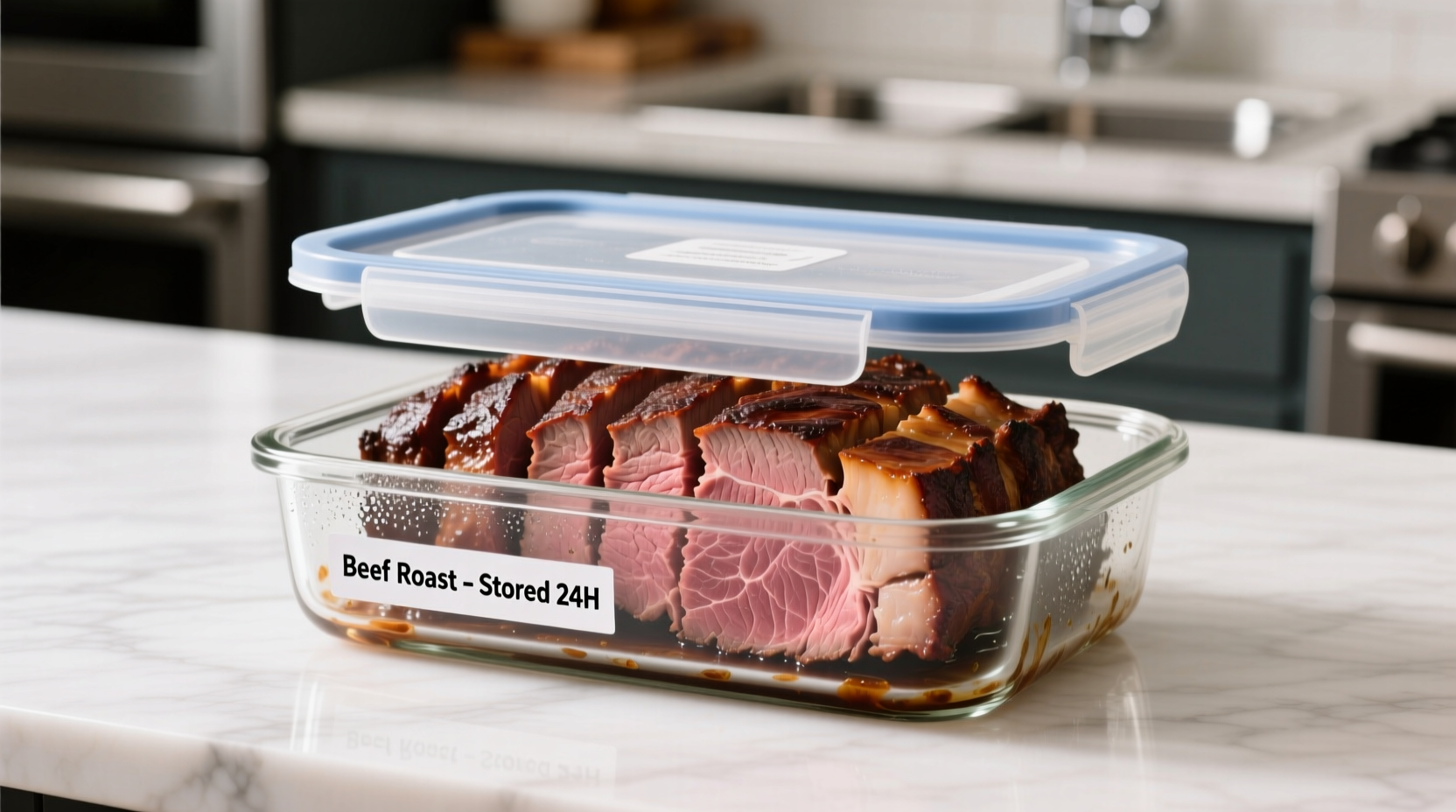Why This Timeframe Matters for Your Health
Understanding how long cooked beef roast remains safe isn't just about avoiding waste—it's critical food safety knowledge. Bacteria like Staphylococcus aureus and Listeria monocytogenes multiply rapidly between 40°F and 140°F, the "danger zone" where cooked meats become hazardous. The USDA Food Safety and Inspection Service confirms that cooked beef enters this risk zone after day 4, making proper timing essential.
What Happens to Beef Roast During Refrigeration
Even when refrigerated, biochemical changes continue in your cooked beef roast. Here's what occurs hour by hour:
| Time After Cooking | Bacterial Growth Stage | Beef Quality Changes |
|---|---|---|
| 0-2 hours | Initial contamination period | Optimal texture and flavor retention |
| 2-24 hours | Slow bacterial multiplication | Moisture begins migrating to surface |
| 1-3 days | Exponential growth phase | Texture becomes slightly drier; flavor intensifies |
| 4+ days | Dangerous pathogen levels | Visible spoilage signs appear; unsafe for consumption |
Proper Storage Techniques That Extend Freshness
How you store your cooked beef roast directly impacts its safe consumption window. Follow these professional kitchen-tested methods:
- Immediate cooling: Divide large roasts into portions no thicker than 2 inches to cool within 2 hours
- Airtight containers: Use glass or BPA-free plastic with tight seals—never leave uncovered
- Temperature verification: Keep your refrigerator at 37-40°F (3-4°C) using a separate thermometer
- Strategic placement: Store on middle shelf where temperature is most consistent

Recognizing When Beef Roast Has Spoiled
Don't rely solely on the calendar—your senses provide critical safety information. Discard cooked beef roast immediately if you notice:
- Texture changes: Slimy or sticky surface film that's visible or detectable by touch
- Odor indicators: Sour, ammonia-like, or unpleasantly sweet smells
- Visual cues: Grayish color, mold spots (any color), or excessive liquid separation
- Taste warning: Any off-flavors—never taste to check safety after day 4
The USDA emphasizes that "when in doubt, throw it out" applies strictly to cooked meats. Pathogens that cause foodborne illness don't always produce noticeable changes in food appearance or smell.
Special Considerations for Different Household Situations
Your specific circumstances may require adjusted timelines:
- Leftovers from restaurants: Consume within 2 days due to unknown handling history
- High-risk households: Reduce timeframe to 2-3 days for homes with infants, elderly, or immunocompromised individuals
- Vacuum-sealed storage: Extends safety to 5-6 days but requires immediate refrigeration after sealing
- Added sauces or gravies: Decreases shelf life to 2-3 days due to additional moisture content
Safe Reheating Practices for Maximum Protection
Proper reheating destroys bacteria that may have developed during storage:
- Heat to internal temperature of 165°F (74°C) measured with a food thermometer
- Reheat only the portion you plan to eat—don't repeatedly cool and reheat
- Stir liquids like gravy halfway through heating for even temperature distribution
- Avoid slow reheating methods like warming plates that keep food in the danger zone
When Freezing Is Your Best Option
If you won't consume your cooked beef roast within 3-4 days, freezing preserves both safety and quality:
- Portion before freezing for single-use servings
- Use freezer-safe containers with 1/2 inch headspace for expansion
- Label with contents and freezing date—best quality within 2-3 months
- Thaw overnight in refrigerator, never at room temperature
Food Safety Resources for Continued Learning
Stay updated with the latest food safety guidelines from these authoritative sources:
- USDA Food Safety and Inspection Service
- Centers for Disease Control and Prevention Food Safety
- FDA Food Safety Education Materials
Frequently Asked Questions
Can I eat cooked beef roast after 5 days in the refrigerator?
No, cooked beef roast should not be consumed after 4 days in the refrigerator. The USDA Food Safety and Inspection Service states that cooked meats enter the food safety danger zone after this timeframe, potentially harboring harmful bacteria even if no visible spoilage signs are present.
Does reheating cooked beef roast extend its safe storage time?
No, reheating does not reset the 3-4 day safety clock. Each time you cool and reheat food, you expose it to the temperature danger zone (40°F-140°F) where bacteria multiply rapidly. Only reheat portions you plan to eat immediately and discard any leftovers from the reheated portion.
How can I tell if my cooked beef roast has gone bad before the 4-day mark?
Check for visible signs including slimy texture, grayish color changes, mold growth, or unpleasant odors like sourness or ammonia. The USDA emphasizes that "when in doubt, throw it out"—never rely solely on appearance as dangerous pathogens may not produce noticeable changes.
Does the type of beef roast affect how long it lasts in the refrigerator?
The cut of beef doesn't significantly change the 3-4 day safety window, but preparation methods do. Roasts with added sauces, marinades, or gravies may spoil faster (2-3 days) due to increased moisture content. All cooked beef products follow the same food safety guidelines regardless of cut.
Can I freeze cooked beef roast to extend its shelf life beyond 4 days?
Yes, freezing cooked beef roast properly extends its safe storage to 2-3 months. Portion into airtight, freezer-safe containers with 1/2 inch headspace, label with date, and thaw overnight in the refrigerator before reheating to 165°F internal temperature.











 浙公网安备
33010002000092号
浙公网安备
33010002000092号 浙B2-20120091-4
浙B2-20120091-4